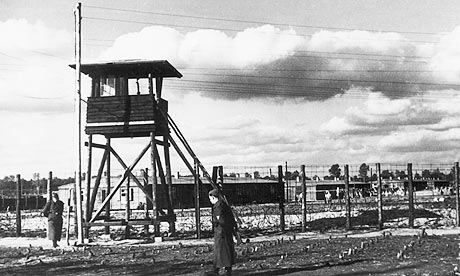
The Christmas present book I am so far most enjoying is the fat 480-pager about the lives of incarcerated Allied prisoners of war between 1939 and 1945. Although I was scarcely a toddler when the war broke out, I am surprised to find that I grew up to work alongside a handful of those who figure in Midge Gillies's engaging The Barbed Wire University.
It is a breezy, edifying history which knits together compelling tragi-comic tales of boredom, stoic ingenuity and sheer courage far beyond the conventional heroic goodie v baddie narratives of such as Colditz and The Great Escape. Veteran Guardian readers will relish the wartime exploits of both our former and fondly loved golf correspondent Pat Ward-Thomas and our distinguished foreign correspondent Terence Prittie.
Two others with whom I was privileged often to share a press box – while never quite realising what a war they had endured – were EW "Jim" Swanton and Wales's luminous rugby-playing cricketer, Wilf Wooller.
Ward-Thomas had baled out of his stricken Wellington bomber over the Netherlands in 1940 and ended up at Stalag Luft 111 at Sagan in Poland, where he filled his days by helping build an ingeniously difficult golf course around the camp's sandy scrubland where greens were "browns", balls and clubs were homemade, and the longest hole only 90 yards long.
Meanwhile Prittie, captured at Calais in 1940, was imprisoned at Oflag VIB in Warburg where (between his six escape attempts, I might add) he said he survived the whole war only by organising serious cricket matches – as he wrote from the camp to The Cricketer in January 1944. "Cricket has been our chief compensation. Whatever we are missing we might, after all, be worse off, for with a cricket bat in his hands, the prisoner of war is rather nearer home than at any other moment of his existence."
War over, and Neville Cardus still in Australia, Prittie contentedly covered cricket for two summers, eventually becoming our long serving and fabled Berlin correspondent. In the early 60s, as a raw sub-editor, I would handle his copy quite often from the desk in London: regularly we got to talk of cricket and I remember as if it was yesterday telling him of Brian Close's epic defiance in the Lord's Test of 1963 and delighting at hearing the contented cheers sea-shelling down the crackly telephone wire from Germany.
The lives of those two singular and dogmatically opinionated coves, Swanton and Wooller, were defined by their incarceration. The latter had been the freewheeling star of rugby's Arms Park before the war and thereafter he at once refashioned Glamorgan cricket, indeed outrageously inspiring championship victory in 1948.
In his wretched Japanese camp, Wooller played chess and darts and even helped organise the betting on frog races, but physical sport was questionable when prisoners were desperate on preserving some sort of fitness; in Wooller's case his weight dropped from 13½ stone to under eight. By 1945 scarcely 500 men of his original detachment of 3,270 captured in Singapore were still alive.
A feature of the ghastly life on the infamous Thailand-Burma railway line had been Swanton's public readings from his battered 1939 Wisden, which was bound in the camp with rice paste and sackcloth and stamped "non-subversive" in Japanese. Swanton had left for war a strapping a 15-stoner; on his return, on the platform at London's Waterloo station, his mother had walked right past her emaciated nine-stone son.
Ward-Thomas had sent an article to Country Life about his ersatz Sagan golf course and at once the R&A had dispatched from St Andrews some "proper" balls and, glory be, a gleaming new steel-shafted driver. Pat told me the full story only on his retirement 30 winters ago.
"Of course its use was forbidden at the camp," he said. "Would it have set off alarm bells all over the place? But every day I used to feel it lovingly, so longingly. In the end I could resist no longer. The chance came one bitter winter day when everyone was inside and the camp deserted. I took the club and a real golf ball to a distant corner and, almost trembling with anticipation, I teed off. By golly – I made perfect contact and the ball soared away out of sight and far over the kitchens' building.
"And then I heard at last the crash of broken glass far away and imagined startled people flinging themselves to the floor in the winter silence, thinking a bullet was responsible ... I felt ashamed, but immensely exhilarated as well. It was the first and last golf ball ever to be hit with a real driver at Sagan."

